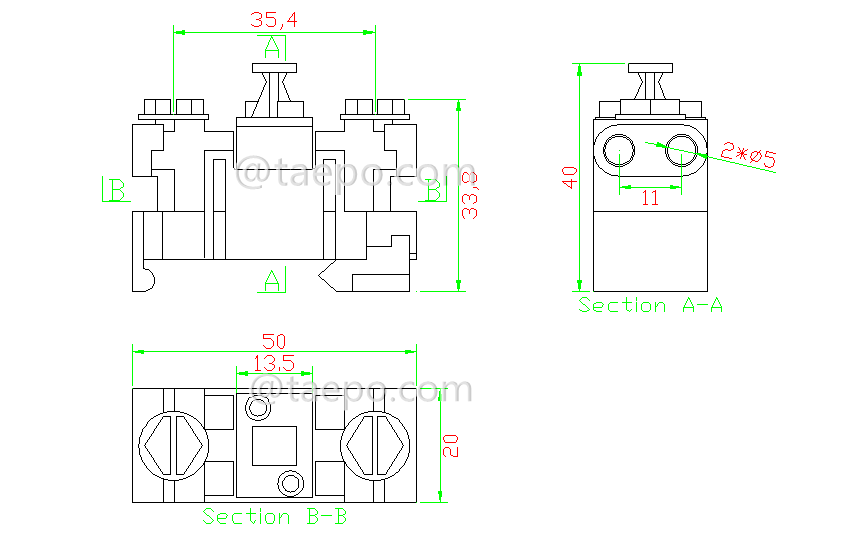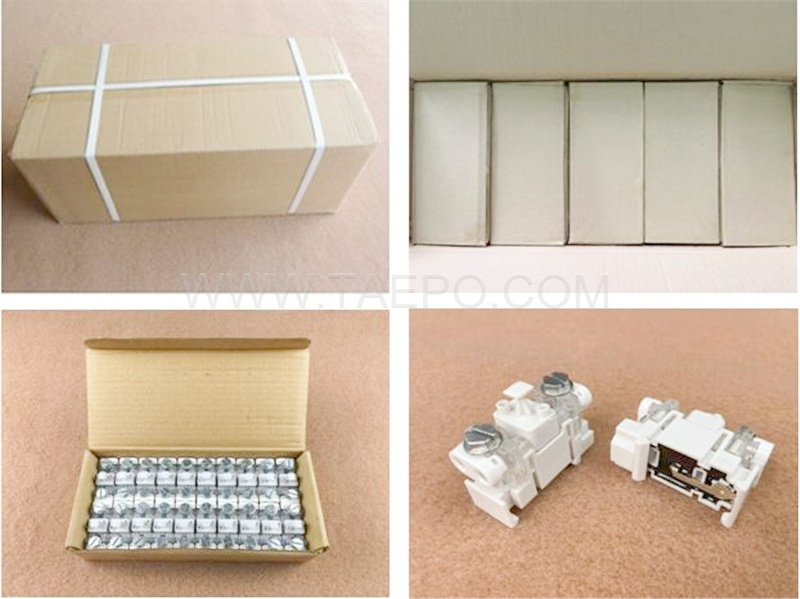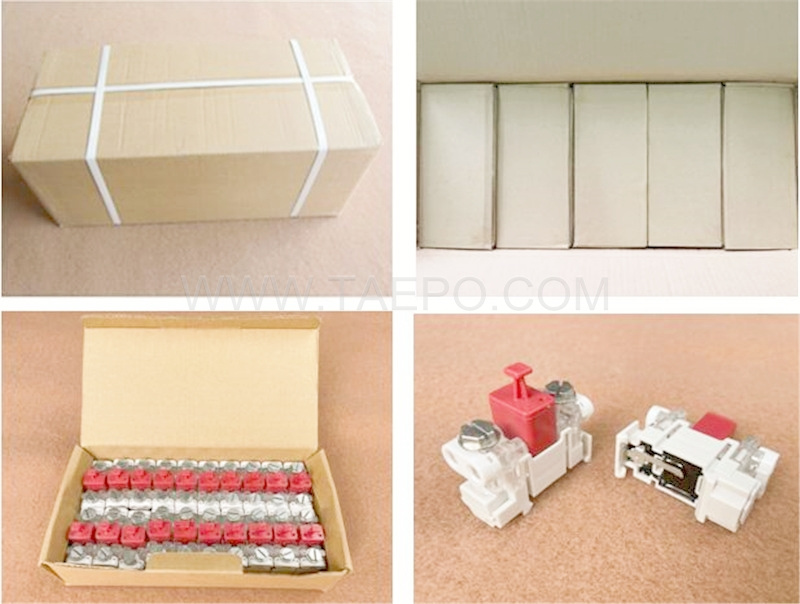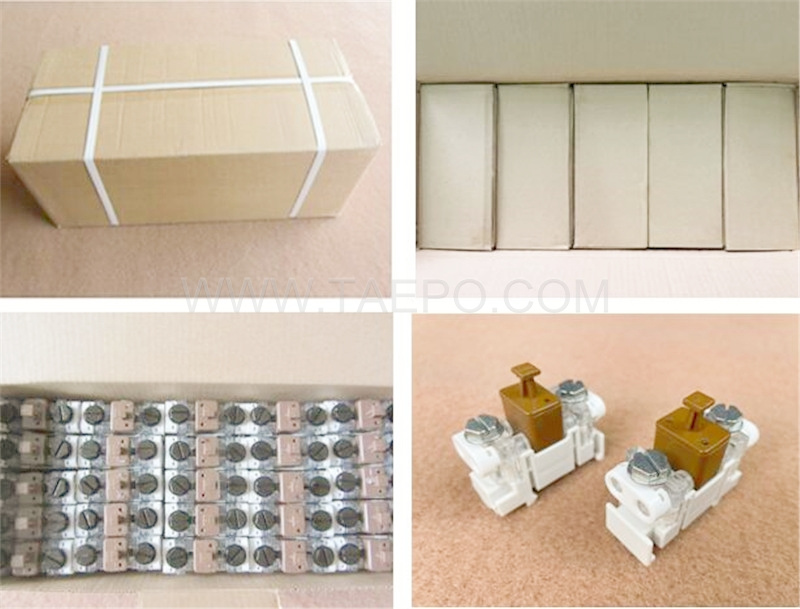What is a VX Module?
1) First, to answer this question, let's show you VX Module's Description in details.
VX module also called as 1 pair dropwire STB module(subscriber terminal bolck ), with or without protection gel filled. We TAEPO has its series TP-1301-1, TP-1301-1G and TP-1301-1GP.
VX Module provides a connection point between an exchange-side cable pair and a distribution pair. It incorporates a 5-point plug in module to provide continuity and a range of other options. It is especially recommended for outdoor connections where the environmental conditions are extremely aggressive.
These VX modules are designed for mounting on a standard DIN rail and can therefore be mounted in a variety of housings in whatever quantities are required. The small footprint (2 cm wide) ensures a compact product.
These VX modules typically consists of a plastic housing with terminals or connectors for connecting the dropwire and the distribution cable. Without protection, it means that the module does not have any built-in safeguards or components to protect against surges, overvoltages, or other electrical disturbances.
The dropwire side of the VX module has insulation displacement contacts (IDCs) to facilitate the connection of the subscriber's dropwire. These contacts allow for a reliable and secure termination of the individual wires within the dropwire, ensuring good electrical connectivity.
On the distribution cable side, VX module may have IDCs as well, which are used to establish the connection with the main distribution cable. The distribution cable is typically a larger cable that carries multiple pairs of wires to serve multiple subscribers.
2) Second, let's learn VX Module's Main Features
- Insulation Displacement Connection: IDC allows for the termination of wires without the need to strip off the insulation. The VX connection is made by displacing the insulation and making direct contact with the conductor within the wire.
- Reliable connections: A reliable connection ensures that signals or data are transmitted consistently and accurately from the source to the destination without loss or distortion
- Modular design and installations: Modular design and installations offer numerous advantages, including flexibility, scalability, simplified assembly, ease of maintenance, interchangeability, standardization, reduced failure risk, efficient testing, and cost savings.
- Termination: The module provides a termination point for a single pair of copper wires from the subscriber's dropwire. It allows for a secure and reliable connection of the individual wires within the dropwire.
- Connection points: The module includes terminals or connectors for connecting the subscriber's dropwire and the main distribution cable. These connection points are insulation displacement contacts (IDCs).
- Compact design: The module is usually designed to be compact and easy to install. It can be mounted on walls, poles, or other suitable surfaces.
- Durability: The module is built to withstand outdoor conditions and has a durable housing that protects the internal components from environmental factors such as moisture, dust, and temperature fluctuations.
- Weatherproofing: It provides a barrier against moisture, preventing water ingress and protecting the internal connections from corrosion.
3) One Question: How does "STB module / VX module" work ?
Answer: Here’s a step-by-step overview of how the Subscriber Terminal Block (STB) module works in a telecommunications.
1. Installation and Setup
- Physical Mounting: The STB module is mounted in a central location, often within a telecom facility or a distribution point.
- Wiring Connections: Subscriber lines (copper or fiber cables) are connected to the STB module terminals. Each line typically connects to a designated terminal block.
2. Connection to the Network
- Incoming Signals: The module connects to the larger telecommunications network, receiving incoming signals from the service provider (e.g., voice, data, or video).
- Signal Entry Point: This may involve direct connections from switches, routers, or other network infrastructure components.
3. Signal Routing and Distribution
- Signal Distribution: The STB module routes the incoming signals to the appropriate subscriber lines. It ensures that each line receives the correct data based on the subscriber’s account.
- Outgoing Signals: When subscribers send data (e.g., making a call or using the internet), the module routes these signals back to the network.
4. Termination of Connections
- Secure Termination: Each subscriber line is terminated at the STB module. This means that the connection is securely clamped or connected, ensuring stability and minimizing signal loss.
- Signal Integrity: Proper termination helps maintain the integrity of the signals, preventing interference or degradation.
5. Electrical Isolation and Protection
- Isolation Features: The STB module provides electrical isolation, protecting subscriber equipment from voltage spikes or surges in the network.
- Protection Mechanisms: Built-in fuses or circuit breakers may be present to safeguard against electrical faults, ensuring the safety of connected devices.
6. Monitoring and Diagnostics
- Monitoring Capabilities: Many STB modules include features to monitor line status (e.g., whether a line is active or experiencing issues).
- Diagnostic Tools: Service providers can use these monitoring tools to troubleshoot problems, ensuring quick responses to service interruptions.
7. Flexibility and Maintenance
- Modular Design: The design of the STB module allows for easy reconfiguration. Technicians can add or remove subscriber lines as demand changes or during upgrades.
- Labeling: Each connection is often labeled, making it easier for technicians to identify and work on specific lines during maintenance.
8. User Interaction
- Subscriber Equipment Connection: Subscribers connect their devices (e.g., telephones, modems) to the terminal block, allowing them to access services like voice calls or internet connectivity.
- Service Usage: Once connected, subscribers can use the provided services, with the STB module facilitating the necessary connections and signal routing.
9. Data Flow Management
- Bidirectional Data Flow: The module manages the bidirectional flow of data—incoming from the network and outgoing from the subscriber—ensuring efficient communication.
- Quality of Service: It may implement features to maintain quality of service, prioritizing certain types of traffic as needed.
10. Updates and Upgrades
- System Upgrades: As technology evolves, the STB module can be updated or replaced to accommodate new services or higher bandwidth requirements.
- Ongoing Maintenance: Regular maintenance ensures that connections remain secure and operational, addressing any issues that arise over time.
This entire process allows the STB module to serve as a vital link between subscribers and the telecommunications network, ensuring reliable and efficient communication services.
4) And then, Let's learn VX Module's Schematic Diagrams
 5) At last, let's See VX Module's Packing Picture
5) At last, let's See VX Module's Packing Picture


 Now, we believe you have basically understood what is a VX Module.
Now, we believe you have basically understood what is a VX Module.
If you have any furter questions, pls contact us freely (sales@taepo.com).
We are convinced we can supply you suitable solutions in Telecommunications Industry.









